How to create, launch, and scale your online course–in 9 steps
Got a skill, a talent, or just something you're crazy passionate about? Why not turn that into an online course and get paid while teaching people what you know?
Maybe you’re already teaching and want to reach more people, or maybe you’re starting from scratch. Either way, now is the perfect time to jump in. Online learning is blowing up—by the end of 2025, the industry is expected to hit $203.81 billion.
People are hungry for knowledge, and they want to learn on their own time, from people who walk the walk.
If you want a piece of this pie, you need to know how to create an online course. There are several variables to consider to make yours profitable and valuable to students. Choosing the right topic, a suitable platform, price points, and promotion are all vital to your success.
We've put together a super practical, no-fluff guide to creating a course that serves your learners and leaves you feeling fulfilled (while bringing in extra income).
Let’s jump right in!
First things first, what is an online course?
An online course is a structured program designed to teach skills, concepts, or knowledge digitally.
One of the biggest advantages of online courses is their flexibility. Learners can take them while working, pursuing other commitments, or simply to acquire a new skill or deepen their understanding of a subject at their own pace.
These courses usually include:
- Video lessons
- Interactive modules
- Live sessions
- Quizzes or knowledge checks
- Downloadable resources
- Community support
Types of online courses
Depending on your course topic and how involved you want to be in the day-to-day, you can offer it in different formats:
Self-paced courses
In self-paced courses, students learn at their convenience using pre-recorded lessons and materials.
Typically, there is minimal interaction between the course creator and learners. This format is ideal if you prefer a hands-off approach and do not want to be actively involved in managing the day-to-day of the course.
Cohort-based courses (CBCs)
Students progress through the course together in a structured, time-bound format with instructor interaction.
A good example of this type of course is Tiago Forte’s cohort-based course, The Annual Review, which helps participants reflect on their past year and create a strategic plan for the year ahead.
With three pricing tiers, the program offers a mix of live and recorded sessions, structured templates, and an interactive Circle community, ensuring both flexibility and accountability for learners at different levels.
"Cohort-based courses can be an amazing way to guide your members through some transformation — together. The live touchpoints give them a chance to receive really specific feedback and guidance, while the group component gives them a chance to connect with and learn from others in the course. If you're able to dedicate the time and resources to creating a cohort-based course experience, it can really be massively transformative and valuable for your members."
- Emma Catranis, Sr. Customer Education Manager at Circle
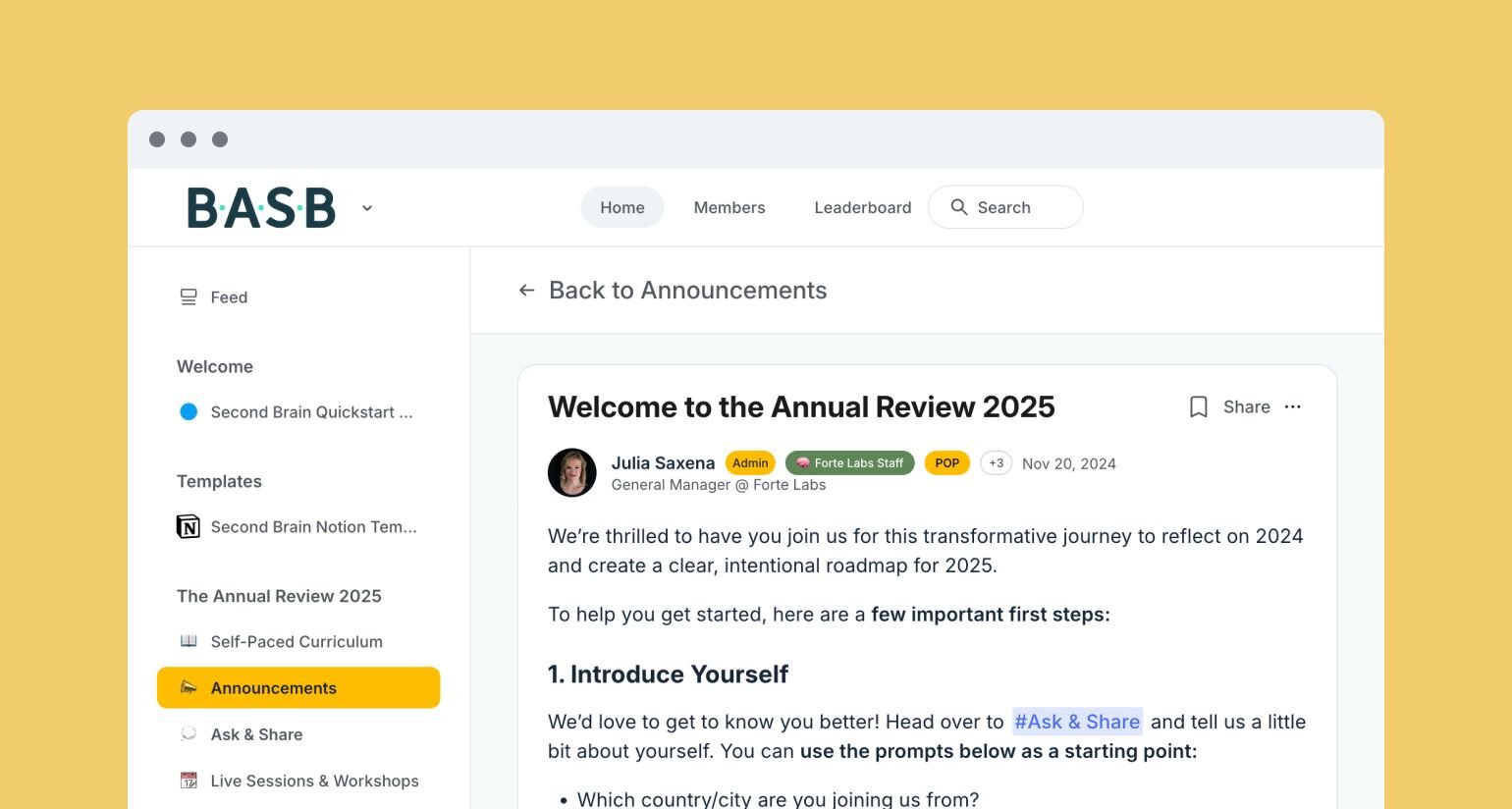
👉 Check out our in-depth guide on how to launch a cohort-based course and succeed with it!
Mini-courses
The cue is in the name. These courses are laser-focused on solving one specific problem, like building a personal brand on LinkedIn or learning how to swing a golf club in under 30 days.
Take Channel in a Weekend, for instance. This mini-course from Karin Carr helps real estate pros set up a YouTube channel that actually attracts clients—in just 48 hours. With step-by-step instructions, ready-to-use templates, and quick video tutorials, it cuts through the guesswork so students can launch a polished, lead-generating channel fast.
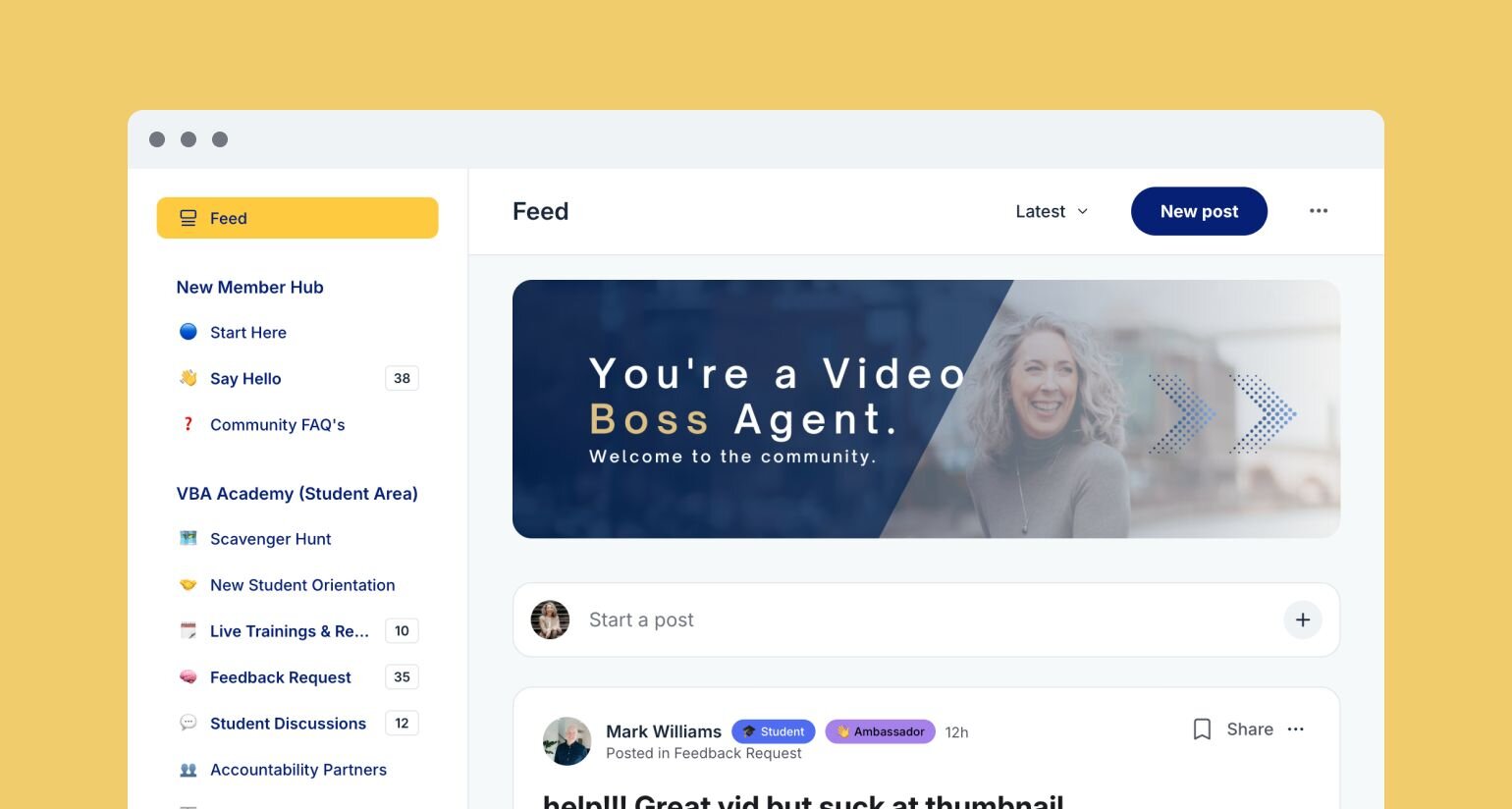
A mini-course can be your sole offer, or you can use it as a low-cost offer to introduce students to your teaching style before leading them into a more comprehensive program.
Masterclasses
A masterclass is a high-level, expert-led standalone session or series of lessons that provide deep insights, advanced strategies, and real-world applications in a specific subject. It’s mainly targeted at learners who want to gain insider knowledge, applicable strategies, and to refine their expertise.
"When you're planning a masterclass, consider what topics your members might be interested in that you yourself are not an expert in. This can be a really helpful starting point, and from there you can start to source experts to bring in to speak on those topics.
For example, I've coordinated expert masterclasses for the Circle community on topics ranging from ChatGPT for community managers to public relations for small business owners. I wouldn't have been able to go deep with either of those topics myself, but the experts I partnered with could."
- Emma Catranis, Sr. Customer Education Manager at Circle
How to create an online course and monetize it in 9 steps
Now, let’s get into the nitty-gritty. Here’s our A-to-Z guide to help you launch a profitable online course (and avoid rookie mistakes).👇
1. Choose the right topic
Nine times out of ten, the topic for your course will come from your passion for a particular subject or your professional experience. But if you’re unsure, we recommend the Ikigai exercise—a tried-and-true Japanese method for discovering your purpose in life.
While your course may not be your reason for living, the method can still be helpful. Ikigai invites you to explore what lies at the intersection of four key elements: your passion, mission, vocation, and profession.
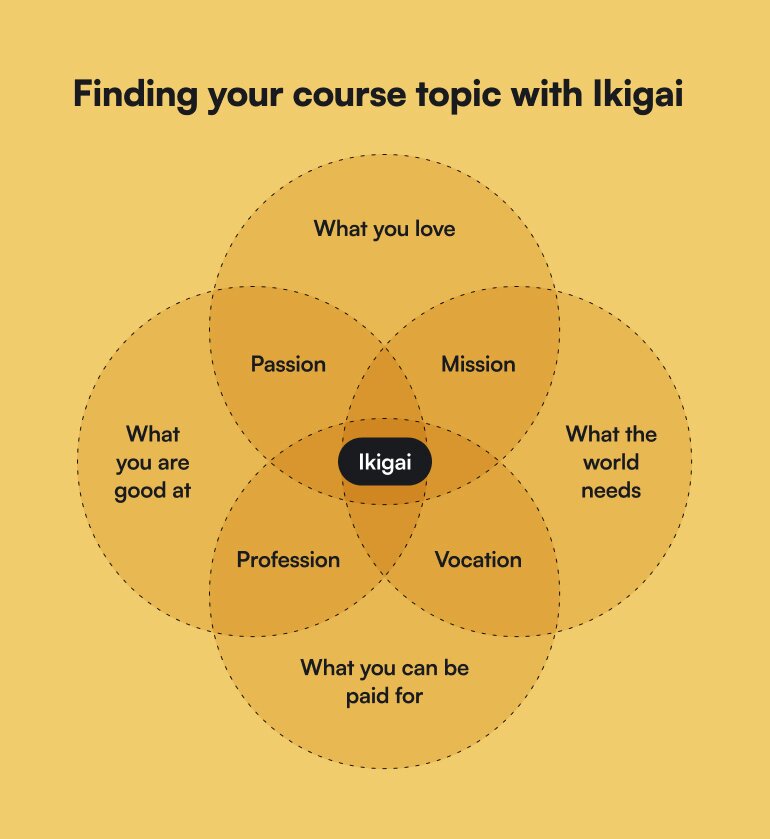
⭐ Passion: What are you good at? What do you enjoy doing?
⭐ Mission: What does the world need? How can you use what you love to do to fulfill a need?
⭐ Vocation: How can you turn your mission into something you can be paid for?
⭐ Profession: How can you monetize your passion?
If you consider these overlapping questions, you should find your topic lies at the center.
Obviously, don’t do this exercise in isolation. Reflect on your credibility and expertise. Think about what you’re known for and what value you can add to others. Examine market and user needs, and problems you may be capable of solving.
Also, make sure your topic isn’t too wide. Codie Sanchez, serial entrepreneur and CEO of Contrarian Thinking, always emphasizes the importance of niching down. And she’s spot on! Focus on what you actually know, and you’ll build a community that gives a damn, a course that’s worth a damn, and a business that thrives.
2. Validate your idea
Before you go all in on creating your course, take a sec to make sure there’s demand. Because without interest, selling it will be tricky—unless you’re just doing it for fun or as a passion project!
There are several tools you can use to gauge demand.
One of the easiest is Google Trends. Simply enter your course topic and analyze its search volume over time. To get a clearer picture, filter by 90 days or 12 months to see if interest is stable, seasonal, or growing.
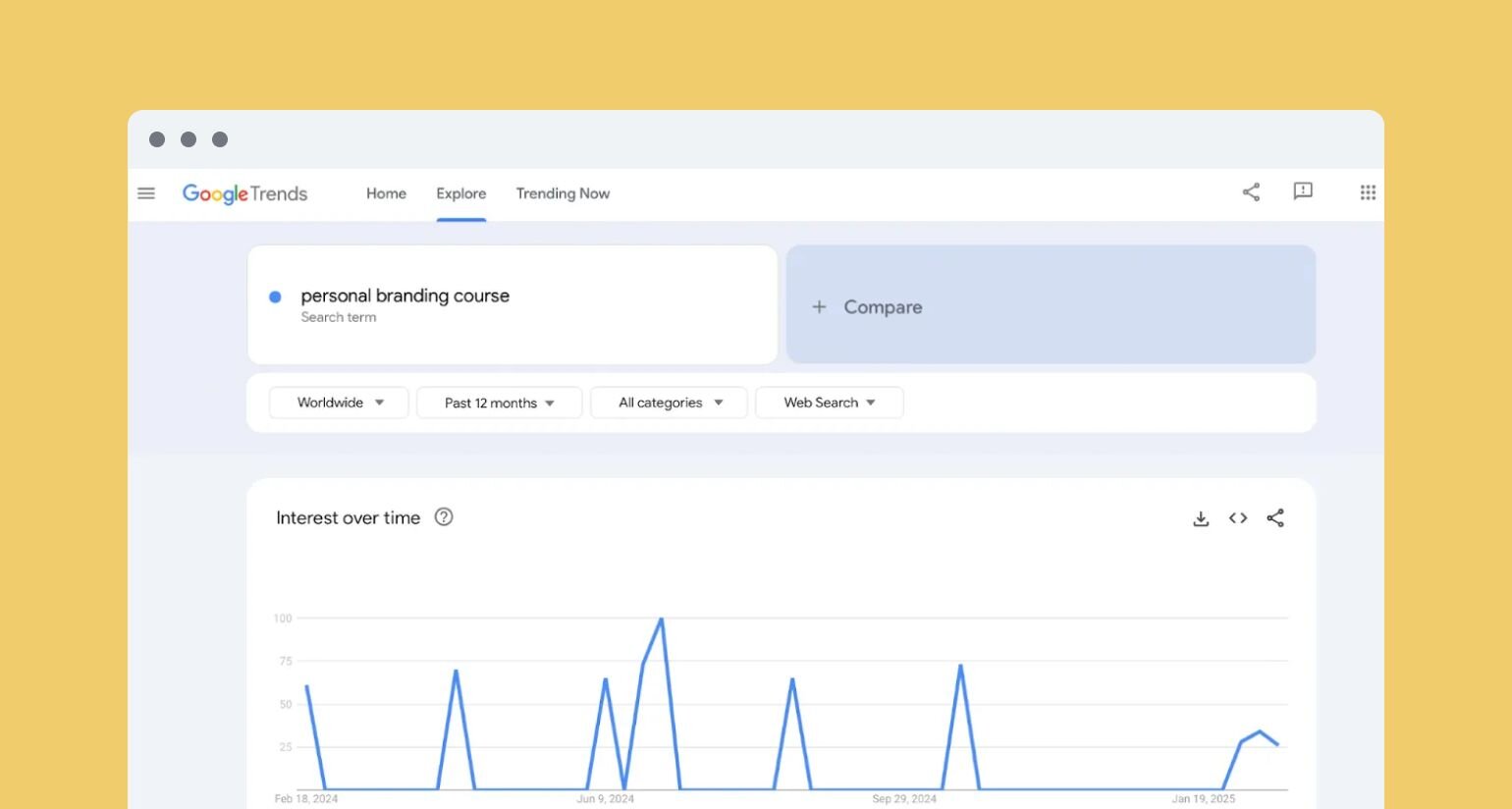
Another handy tool is Semrush. While it’s traditionally used by marketers for keyword research, it can also help you gauge demand for your course topic, just like Google Trends.
With its Keyword Overview tool, you can:
✅ See how many people search for your topic each month.
✅ Discover related keywords to explore alternative course angles.
✅ Analyze competition.
Semrush offers a free account with up to 10 keyword searches per day, which is plenty for a basic research session. Just sign up, head to Keyword Overview, and type in your course topic.
For example, let’s check the demand for a "video editing course." As you can see, it gets 2,900 searches per month.
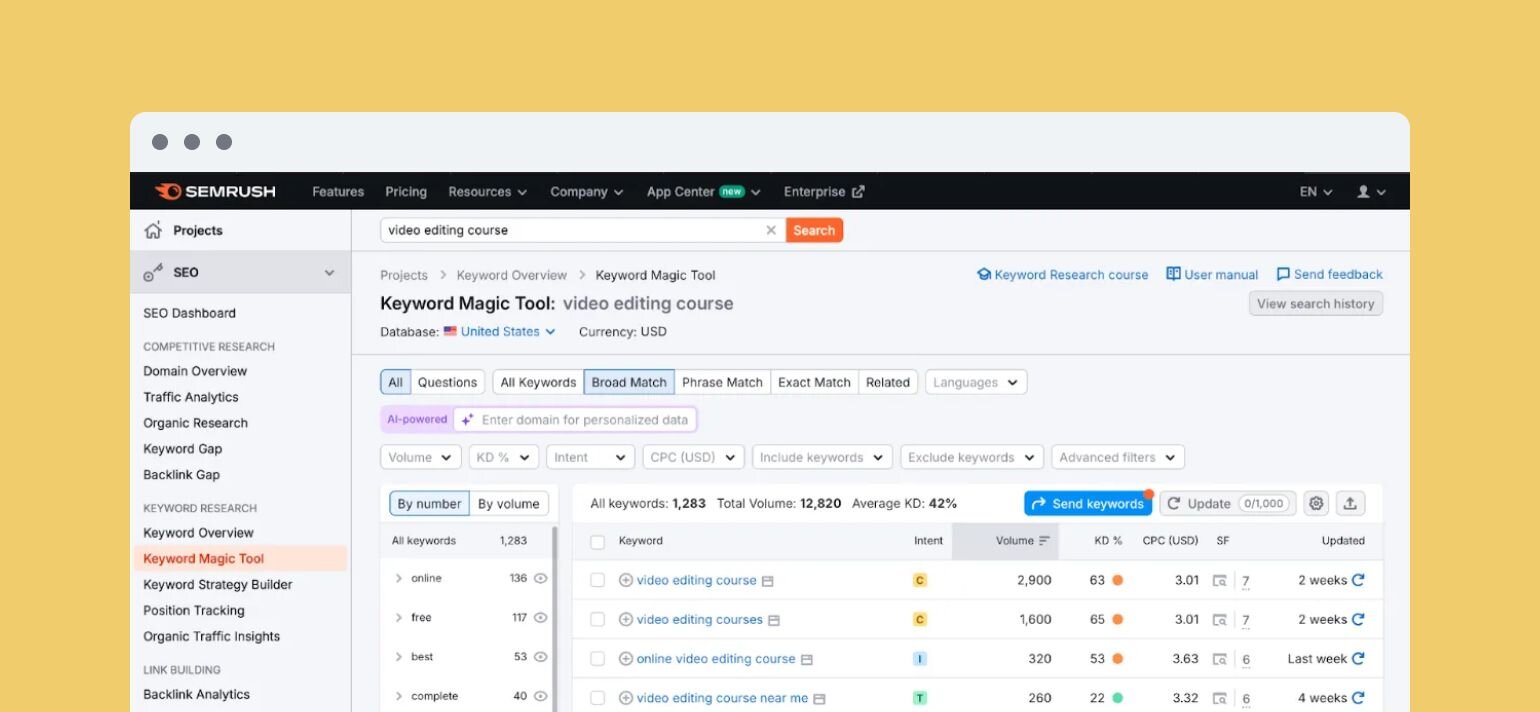
Another topic, "online dog training course," has 1,300 searches per month.
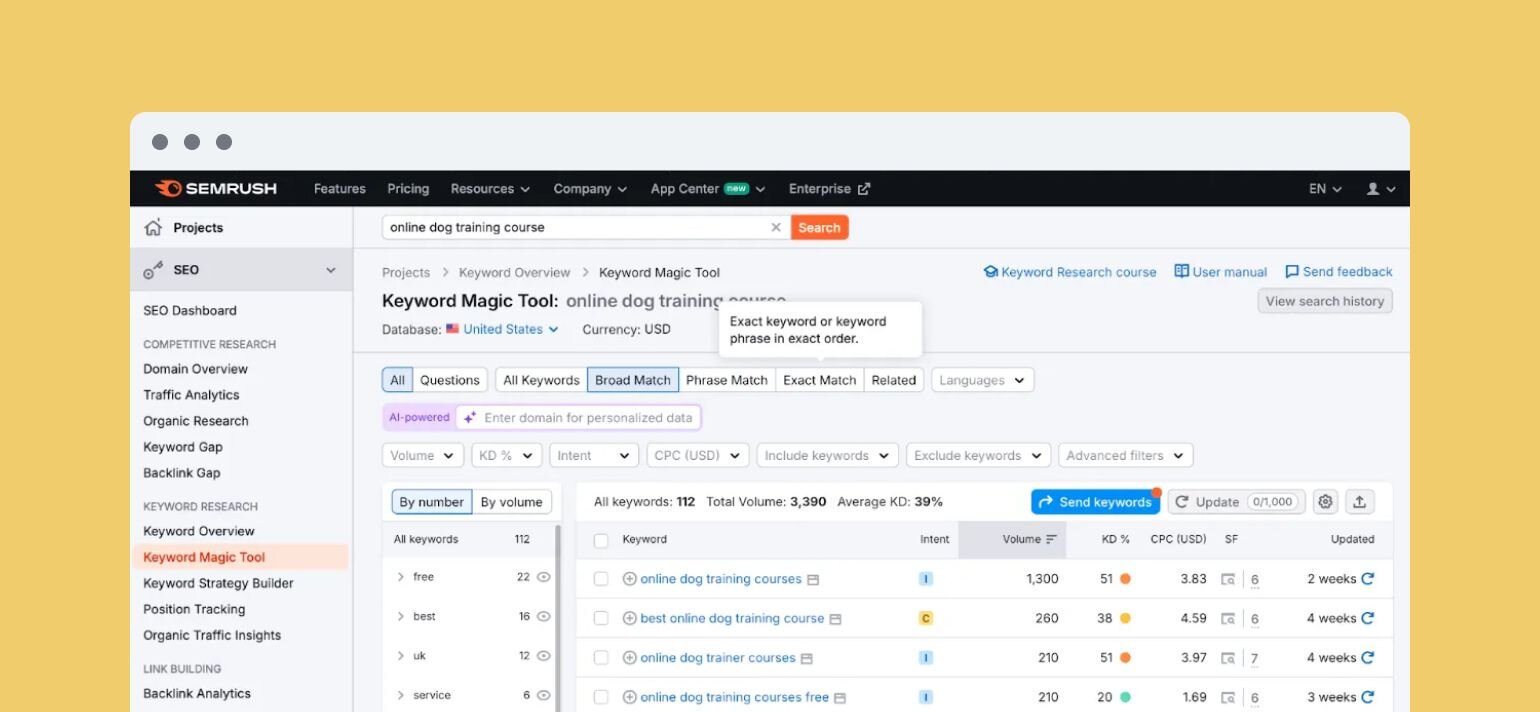
Other ways to test the waters:
- Talk to your target audience: Talk to potential students through social media, newsletters, or communities to understand if they’d be interested in your course.
- Search your course topic on Reddit or Quora: Dive into discussions on these platforms to see what questions people are asking and what problems they’re trying to solve.
- Check your competitors: Browse through popular online course platforms to see if similar courses exist. If competitors are successfully selling a course on your topic, it’s a sign there’s demand—just find ways to make yours better.
- Test with an MVP, webinar, or mini-series: Create a stripped-down version of your course—this could be a live webinar, a short video series, or a beta version. Promote it to your audience and gather feedback.
3. Outline your content
Once you’ve validated your idea, it’s time to outline and structure your course in a way that makes sense for your students. And works with your topic.
Choose your course format
The first step is choosing your course format. Here’s what works best for different types of topics—and why! 👇
| Course type | Best for | Examples | ~Time to create |
|---|---|---|---|
| Mini-course | Teaching a specific skill or solving a single pain point. | Freelance Writing 101 Instagram Growth for Coaches | 2-4 weeks (Scripting, recording, editing). |
| Masterclass | Positioning as an industry expert, delivering in-depth training, live Q&A.
| High-Ticket Sales Mastery Personal Branding | 4-6 weeks (Advanced production, slides, Q&A prep). |
| Multi-day/week/month course | Long-term transformation, skill mastery, community-driven learning.
| 90-Day Business Accelerator 12-Week UX Design Course | 8-12+ weeks (Live sessions, assignments, community engagement). |
| Self-paced course | Flexible learning with evergreen content, allowing students to progress at their own speed. | Financial Freedom Blueprint How to Launch & Scale a 6-figure Store | 4-10 weeks (Pre-recorded content, quizzes, workbooks) |
| Cohort-based course | Community-driven learning with live coaching and group accountability. | First-time Investor Bootcamp B2B Sales Accelerator: Master Enterprise Sales & Land Lucrative Clients | 6-15 weeks (Curriculum design, slides, worksheets, community setup, live session prep). |
Focus on student absorption
You also have to think about students’ ability to take in course material.
If you feel tempted to pack in as much content as possible because students are paying, don’t!
Studies show that most information loss happens within a month, not because students forget entirely, but because new material overwrites the old. When a course is too dense, students might feel like they’re learning, but without reinforcement, most of it fades fast.
To prevent cognitive overload:
- Limit information density: Stick to 3 to 5 key points per lesson to match how much working memory can handle at once.
- Use diverse teaching methods: Mix visuals, audio, and interactive activities to engage different learning styles and reinforce concepts.
- Give guided summaries: At the end of each lesson or module, provide a quick recap of the main takeaways. That way students can consolidate what they’ve learned without having to sift through the entire lesson again.
4. Select a platform
Once you've chosen your topic and decided on a format, the next step is finding the right hosting platform. The best tool for you will depend on your course's scale, your audience's needs, and the type of content you’re offering.
Let’s take a look at some examples.
All-in-one course platforms
All-in-one course platforms enable you to build your course and community in one platform. Some popular platforms include:
- Circle
- Teachable
- Thinkific
Online course marketplaces
Online course marketplaces will host your course in a catalog of courses that learners can browse through. The biggest names in this category are:
- Udemy
- Coursera
- Skillshare
- LinkedIn Learning
Standalone course platforms
These platforms are great for smaller creators, offering everything you need to create, sell, and market courses in one place. Popular options include:
- Podia
- Kajabi
- LearnWorlds
5. Create the course content
Creating your course content is the toughest part—hands down. Do this👇
Structure your course in a logical way
The most basic setup for any course? Build it around modules and lessons.
Modules = The big picture. Each module should focus on a key stage of the learning journey. Think of them as “chapters” of a book.
Lessons = The building blocks. These break down concepts into bite-sized, digestible steps that keep learners moving forward.
Say, you’re running a course "How to Land a Five-Figure Freelance Copywriting Deal in Under 30 Days." This is how you’d structure your content:
| Module | Lesson |
|---|---|
| Module 1: Laying the Groundwork for High-Paying Clients | Lesson 1: The Mindset Shift – Think Like a High-Value Copywriter Lesson 2: Niching Down for Profitability Lesson 3: Crafting an Irresistible Portfolio (Even Without Experience) |
| Module 2: Finding and Pitching High-Paying Clients | Lesson 4: Where to Find Clients Who Pay $3K+ Per Project Lesson 5: Crafting the Perfect Cold Pitch (Without Sounding Desperate) Lesson 6: How to Get Clients to Say Yes Without Haggling |
| Module 3: Delivering and Scaling for Long-Term Success | Lesson 7: Writing Copy That Clients Can’t Wait to Pay For Lesson 8: Streamlining Your Workflow for Faster Turnarounds Lesson 9: Scaling Beyond One-Off Projects – Turning Clients into Recurring Revenue |
Define clear learning objectives
Without clear learning objectives, your course is just a content buffet—students will grab what they like but leave without a full meal. You need to guide them toward a specific result.
What makes a great learning objective?
- Actionable – Use verbs like “implement,” “analyze,” and “create,” instead of “learn about” or “understand.”
- Measurable – The objective should have a clear way to track progress or assess success. Ask yourself: How will students prove they've learned this skill? This could be through a quiz, a completed project, a written response, or successfully applying the concept in a real-world scenario.
- Relevant – Does it help them achieve the transformation they signed up for? If not, ditch it.
Determine the appropriate content format
The way you present your course matters just as much as the content itself. The right format can make learning easier, more engaging, and more memorable. So, take a moment to think about what you're teaching and how your students will best absorb the information.
Here’s a breakdown to help you decide:
- Videos (live or pre-recorded) → Best for demonstrations, personal connection, and visual learners.
- Text guides → Great for step-by-step instructions, deep dives, and those who love to read.
- Quizzes & assignments → Keep students engaged and make sure they actually get it before moving on.
- Interactive activities → Like worksheets, group discussions, or hands-on projects to lock in what they’ve learned.
The golden rule? Mix them all up!
Get people to finish your course
Lastly, people will need a little push to actually complete your program. Use these tactics to make it a bit more fun and keep your learners motivated:
🔥 Progress tracking: If people don’t see progress, they’ll lose interest fast. Give them clear tracking—percentages, or checklists, or “X lessons left” reminders.
🏆 Achievement milestones: Break the journey into wins with badges, certificates, or shoutouts.
🎮 Gamification: Make it interactive with quizzes, challenges, or rewards.
6. Set goals and pricing: How much to charge for your online course?
Pricing your online course can feel overwhelming. Charge too much, and you worry no one will buy. Charge too little, and you risk undervaluing your expertise. So, where do you start?
Define your core offer
Instead of pulling a number out of thin air, begin with your core offer—a concept that Ali Abdaal, creator of Part-Time YouTuber Academy and Productivity Lab, swears by. The core offer is the transformation or outcome your course provides. The clearer and more impactful the result, the more confidently you can position it as a premium product.
Ali argues that higher ticket pricing works best when you position yourself as premium. If your course teaches a high-income skill, helps people start a business, or offers exclusive mentorship, you can price it accordingly.
On the other hand, if your course serves as an entry point to your business—perhaps as a lead magnet or a stepping stone to a higher-priced program—it may make sense to price lower to attract more students and build trust.
Factor in costs
While pricing should reflect value, it also needs to cover costs. Many course creators underestimate expenses, leading to razor-thin margins.
Consider:
- Course platforms: $30–$400/month
- Freelance video editor: $50–$150/hour
- Freelance graphic designer: $50–$100/hour
- Marketing & ads: $500+ per campaign
- Software & equipment: Cameras, mics, and editing tools add up fast
Choose a pricing model that works
You should also ask yourself: Where does this course fit into my business?
- Is it your primary revenue driver?
- A lead magnet?
- Part of a membership?
To illustrate, here’s how different price points impact revenue:
| Course price | # of Students | Sales revenue |
|---|---|---|
| $25 | 400 | $10,000 |
| $50 | 200 | $10,000 |
| $100 | 100 | $10,000 |
| $250 | 40 | $10,000 |
| $500 | 20 | $10,000 |
A $25 course might seem more accessible, but you’d need 400 students to hit $10,000—versus just 20 students at $500. Lower prices mean more volume, but are you prepared to support that many students?
And don’t assume cheap = more sales. Potential buyers may see a cheap course as low value. Plus, marketing a $50 course often takes just as much effort as marketing a $500 course. So, why not price it higher?
By the same token, if you’re providing an introductory course, you might want to maintain a lower price. Research what other course creators charge for similar courses to get some insights.
💡 Expert tip: Presell your course to validate demand before investing heavily in production. If people buy at your target price, you’re on the right track.
7. Launch and promote your course
Once you’ve chosen your platform and created your content it’s time to launch. Circle Contributor Gwyn Wansbrough recommends cultivating an interest list and giving them early access in a pre-launch.
For your official launch, promote everywhere you can. Wansbrough suggests pushing outside your established community to attract “fresh eyes”. Early access for your existing community is great for building loyalty, but remember you need to grow.
Other ways you can promote include:
- Webinars
- Podcasts
- Social media
- Mailing lists
Also, familiarize yourself with SEO tactics to drive leads to your course landing page through organic searches. Optimizing your content can help you tap into new markets outside your usual niche.
8. Gather feedback and testimonials
Your students’ feedback is pure gold. It helps you improve your course and acts as social proof to bring in more enrollments.
But great testimonials don’t just appear out of thin air—you need a system. That’s why it’s a good idea to embed feedback into your course experience to build a feedback loop:
✅ Kickoff survey: Ask students what they hope to gain from the course.
✅ Mid-course check-in: Ask a simple “What’s your biggest breakthrough so far?” or sprinkle in pop-up surveys like, “Are you enjoying this lesson?” or “How would you rate this module?” to see what’s working and where students might be struggling. If possible, jump in right away to offer extra support—it’ll help keep small hiccups from turning into bigger roadblocks later. By the way, our tool, Circle, can help you with this thanks to its automated workflows that can send a personalized outreach message to your students.
✅ Post-course wins: Follow up with students 1-2 weeks after completion and ask what results they’ve achieved. While you’re at it, see if they’d be up for writing a quick testimonial—or even recording a short video about their experience.
Also, consider giving students course completion certificates. It’s a nice touch and gives them something to share on LinkedIn or Instagram—aka, free exposure for your course.
At the end of the day, you want your students to feel proud of their progress—and excited to spread the word about your course.
Circle Partner Rachel Starr shares a practical video on automating certificate creation with Canva. Check it out below!
9. Build a learning community
If you wanna build the best online course (and let’s be real, why wouldn’t you?), you gotta create a community.
Unlike in-person classes, online learning can get isolating. Without peers to check in with or bounce ideas off, it’s easy to feel disconnected—and that can make it harder to finish the course.
Studies on MOOCs (Massive Open Online Courses) show that social learning—basically, learning with and from others—helps more people stick with courses and complete them.
A platform like Circle makes it easy to create that kind of space, helping students stay connected and motivated.
It’s an all-in-one community platform that brings discussions, live events, courses, and direct messaging together in one place. Instead of juggling multiple tools, you can create a seamless learning experience where students connect, ask questions, and engage with your content—without ever feeling isolated.
Circle makes it easy to organize discussions, host live Q&As, set up private group spaces, and monetize your community with paid memberships or subscriptions. With built-in integrations and custom branding, you can shape your community to fit your course’s unique needs.
Real course-creator case studies
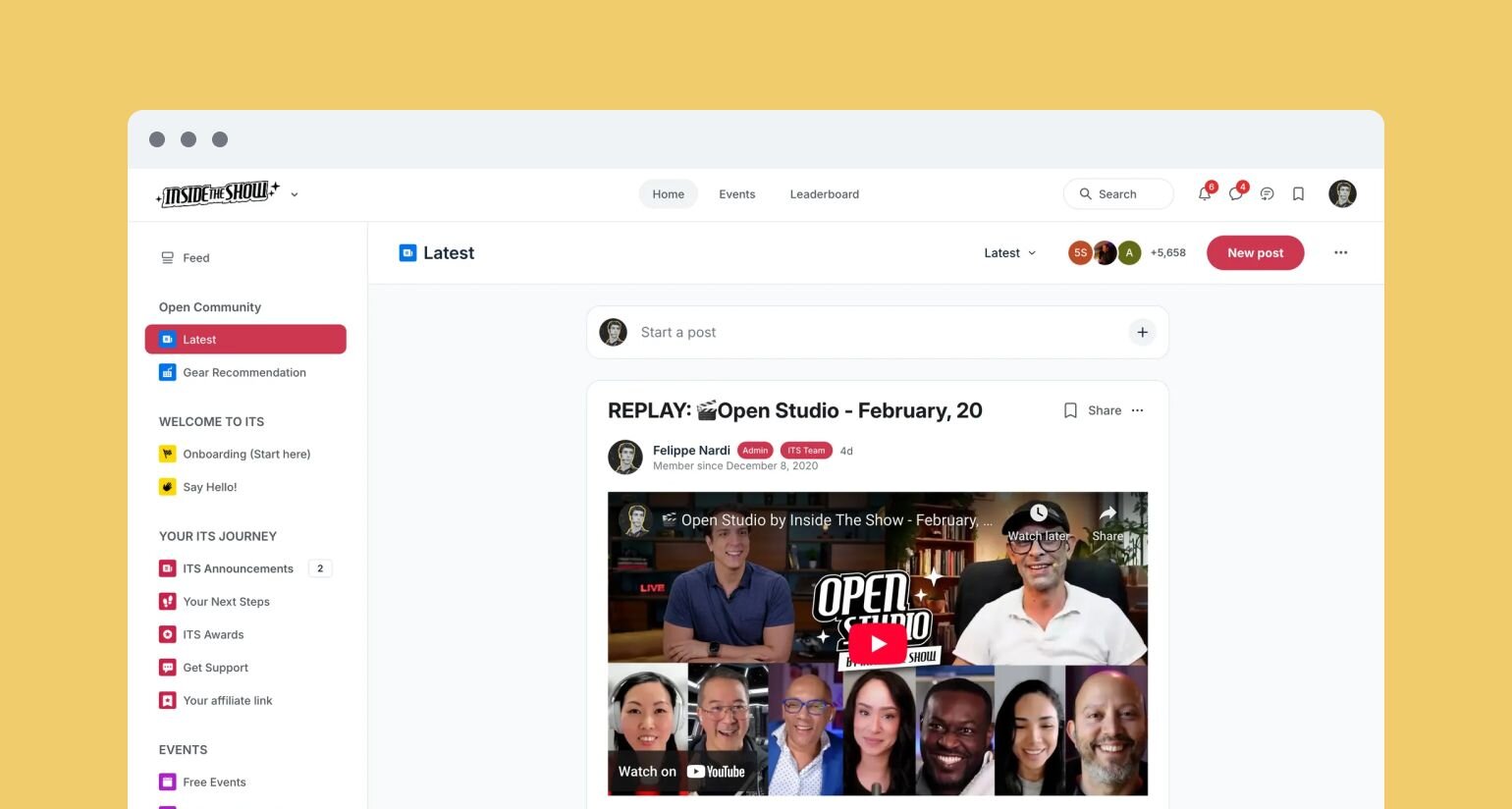
Felippe Nardi, founder of Inside The Show, built a thriving community for presenters, coaches, and creators looking to master virtual sessions. Using Circle, he created a week-long interactive masterclass that gave potential members a real taste of the community experience before committing. This strategy led to a six-figure course launch, with 50% of seats sold before enrolment even opened, and a growing membership of over 2,000 people from 55 countries.
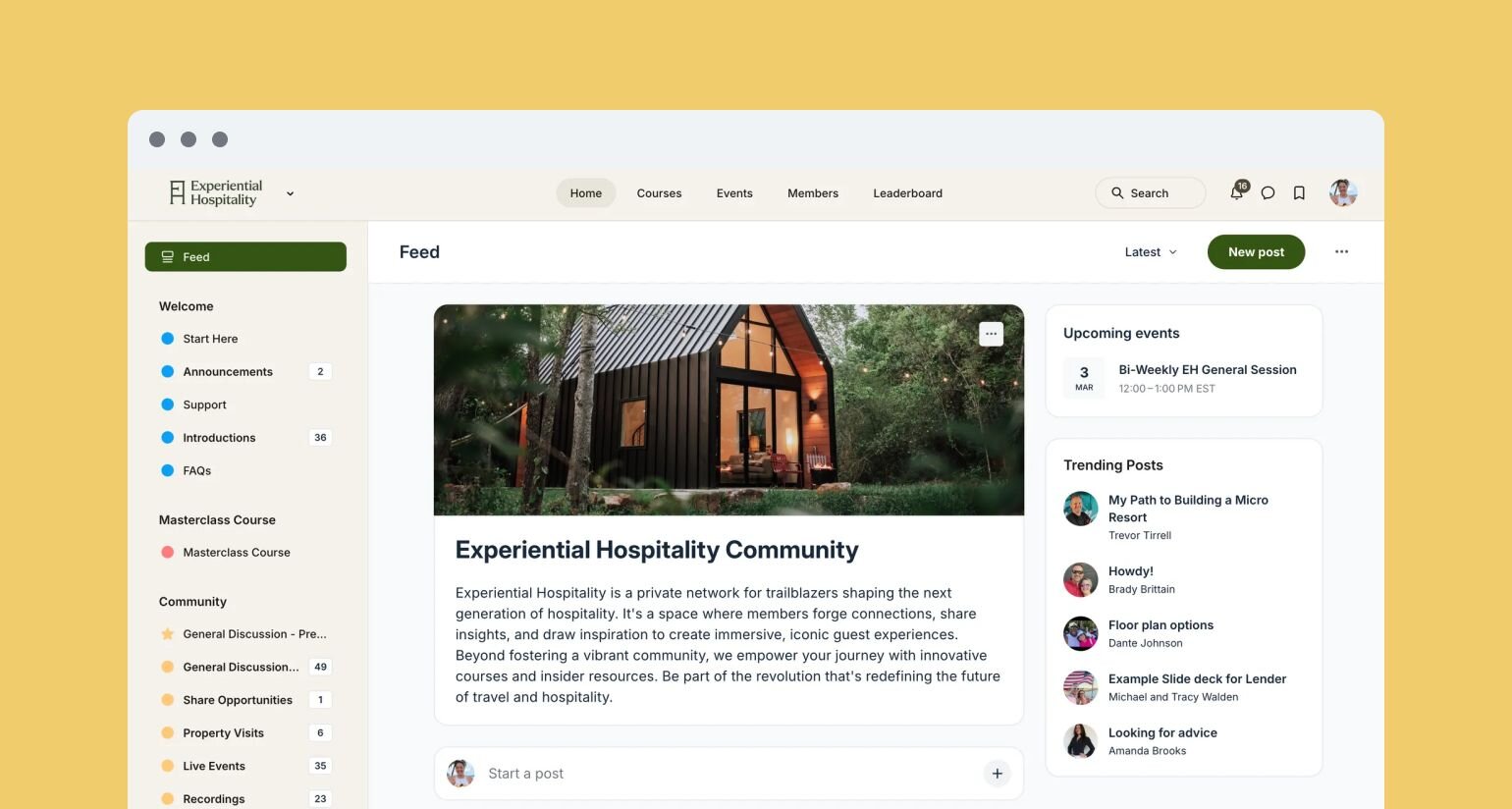
Similarly, Isaac French, founder of Experiential Hospitality, started with a standalone course for short-term rental hosts but quickly realized his audience needed more than just lessons—they needed a network of peers. With Circle, he transformed his offering into an interactive membership community, complete with live deep dives, structured discussions, and direct mentor access. This shift resulted in over $500K in course sales.
At the end of the day, learning is better when it’s shared. Circle helps you build that space, keeping students engaged and connected every step of the way.
Common mistakes to avoid when creating an online course
Creating a course is exciting, but making one that actually sells and helps students succeed is a different game.
Many first-time course creators make mistakes that hurt engagement, completion rates, and credibility. Avoid these pitfalls:
- Failing to set clear learning objectives: Your students want to know what they will learn by the end of your course. That’s your promise, and you need to spell it out as clear learning outcomes. Make them specific, like: “By the end of this course, you’ll be able to launch your first Facebook ad campaign with a $10/day budget.”
- Making it too passive: If your course is just videos and slides, students will tune out. People learn best when they actively apply what they’re learning through exercises, real-world projects, and downloadable workbooks. If your course is live or cohort-based, you can also use breakout discussions, peer reviews, office house, or Q&A sessions.
- Overlooking production quality: Does your course audio sound like it was recorded underwater with a '90s-era mic? Instant engagement killer! Prioritize clear audio—even a basic external microphone can make a significant difference. If you're on camera, ensure a well-lit, distraction-free setup.
- Inadequate testing and feedback: Don’t launch without feedback. First, test a mini or beta version of your course. Invite a few people to try it for free or at a reduced fee. Their insights will help you spot areas for improvement before the big launch. Also, test the platform that hosts your course. Make sure everything works—modules load, downloads function, and videos play without issues.
- Ignoring accessibility and usability: Make your course accessible to all learners by adding captions for videos, providing downloadable transcripts, and using clear, high-contrast visuals.
Over to you
Now you’ve decided on what to include in your course, where to host it, how to price it, and how to launch it, what are you waiting for? Share your knowledge loud and proud.
And if you’re looking for a community platform that doubles as a course creation tool—you’re in the right place.
Circle brings together your members, discussions, events, courses, and content—all in one place, under your own brand. Plus, you get access to our customer community full of handy resources and over 13,000 community builders on the same journey as you.